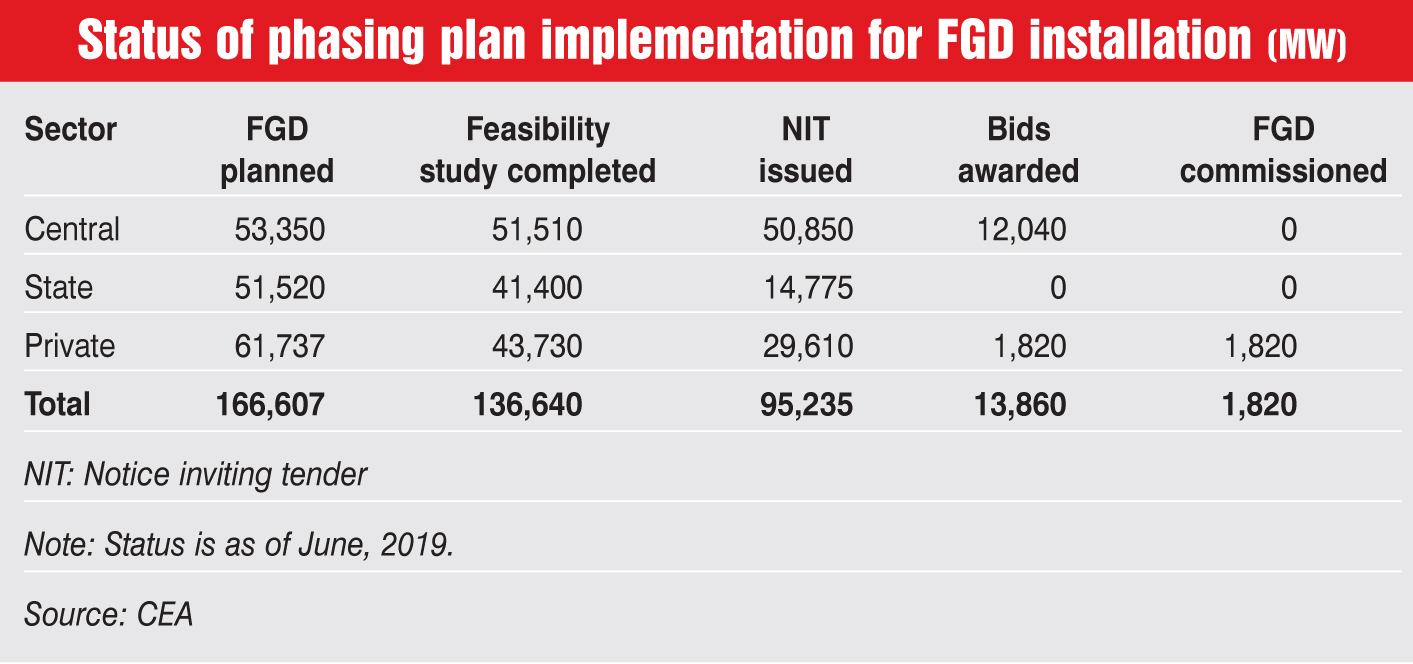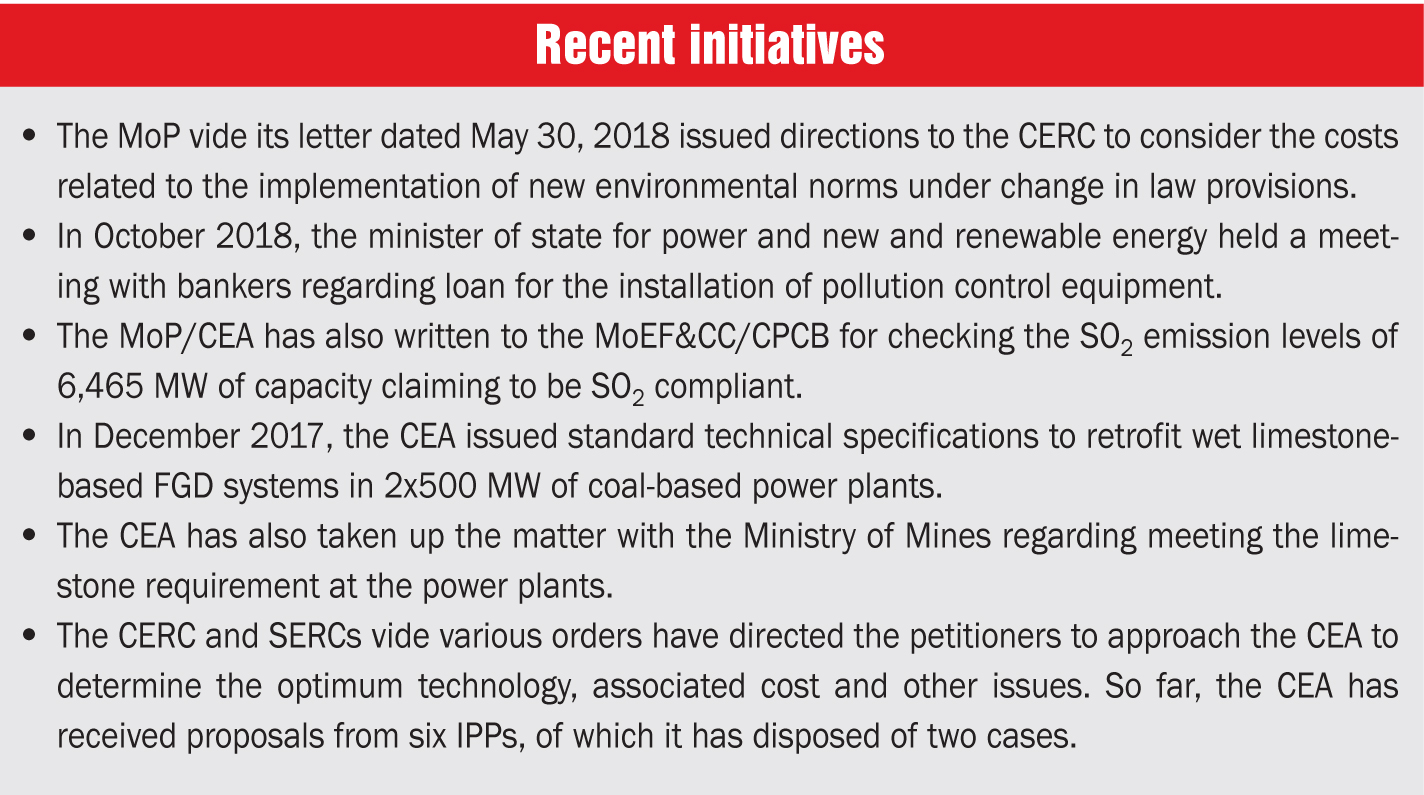
India is the largest emitter of sulphur dioxide (SO2) in the world. SO2 emissions are a significant contributor to air pollution. The largest sources of SO2 are thermal power plants (TPPs) and other industrial facilities that burn fossil fuel. In December 2015, the Ministry of Environment, Forest and Climate Change (MoEF&CC) introduced SO2 emission norms for coal-based power plants with an initial deadline of January 2017. The emission limit for TPPs installed up to December 31, 2016 was 600 mg per Nm3 for units smaller than 500 MW and 200 mg per Nm3 for units above 500 MW. For all TPPs installed January 1, 2017 onwards, the limit was 100 mg per Nm3. However, at the request of the Ministry of Power (MoP) and power plant operators, the deadline was extended till December 2019 for power plants in Delhi-NCR and till 2022 for other power plants across the country, through a Supreme Court order.
Phasing plan for FGD
A detailed phasing plan was prepared by the Central Electricity Authority (CEA) to outline the roadmap for the installation of flue gas desulphurisation (FGD) systems for SOx control. The plan was sent to the MoEF&CC in June 2017. A detailed report was prepared for meeting the new norms without any shortfall in electricity supply. Accordingly, an implementation plan, with a timeline of 2022, was submitted by the MoP and finalised by the CEA in consultation with stakeholders. The MoP forwarded it to the MoEF&CC in October 2017.
 The FGD phasing plan covered 415 coal-based units with 161,552 MW of capacity. The phasing plan for the installation of FGD and other pollution control equipment at TPPs in NCR, near large habitations and in critically polluted areas were prioritised. Of these, 414 units aggregating about 160,000 MW of capacity submitted implementation plans to install FGD systems to meet the SO2 norms. However, progress on FGD implementation remains low. As of June 2019, FGDs have been commissioned for only 1,820 MW of capacity while bids have been awarded for 13,860 MW or 8 per cent of the planned capacity.
The FGD phasing plan covered 415 coal-based units with 161,552 MW of capacity. The phasing plan for the installation of FGD and other pollution control equipment at TPPs in NCR, near large habitations and in critically polluted areas were prioritised. Of these, 414 units aggregating about 160,000 MW of capacity submitted implementation plans to install FGD systems to meet the SO2 norms. However, progress on FGD implementation remains low. As of June 2019, FGDs have been commissioned for only 1,820 MW of capacity while bids have been awarded for 13,860 MW or 8 per cent of the planned capacity.
 Issues and challenges
Issues and challenges
Despite continued efforts, there are numerous challenges in the implementation of SO2 norms such as limited vendor availability globally for DeSOx equipment, lack of skilled manpower and time constraints. The installation of an system FGD takes about three years from the date of order placement. The unit is shut down for making necessary connections for a period ranging from two to six months depending on the technology adopted by TPPs (construction of low height chimney/lining of existing chimney, etc.). Further, a minimum time of about six months is required for tender bidding and finalisation. There are also constraints on limestone availability and transportation.
Also, there are funding constraints in the installation of emission reduction equipment. As per inputs received from utilities, the bidding price for wet-type FGD varies from Rs 3 million to Rs 6 million per MW depending on the location, type and age of units, coal quality, etc. The additional capex required to comply with the SOx emission norms is estimated to increase the levellised cost of generation of a coal-based power plant by 11 paise to 13 paise per unit, thus increasing the retail tariffs by 2.1-2.4 per cent from the prevailing tariff level. In addition, wet FGD systems incur an additional cost on account of reagent (limestone), water consumption and disposal of the by-product (gypsum). Further, the installation of FGD systems increases the auxiliary consumption of power plants by 1-2 per cent.
At the equipment level, there are various problems that need to be managed by generators. The performance of FGD processes is affected by parameters such as liquid-to-gas ratio (the higher the better), gas and liquid distribution, gas velocity and drop in pressure, turndown capability, scale formation, chloride control (lesser the better), limestone fineness and absorber tank pH and density. Further, FGD operation can result in blade erosion, sulphur deposits on blade and high vibrations. Ring hammer unbalancing can cause high vibration in the limestone crusher. There could also be crusher choking when moisture ingresses during rain as well as choking at bucket elevators. The slurry cyclone separator could face clogging of diverter valves and slurry pipelines. Meanwhile, the absorber agitator can face issues such as slurry leakage, impeller damage, mechanical seal failure and bearing damage.
 The way forward
The way forward
Utilities need to adhere to the phasing plan for the installation of pollution control equipment as per notices issued by the Central Pollution Control Board (CPCB). The MoP has approved the pass-through of capital/operational costs under change in law through directions to the Central Electricity Regulatory Commission (CERC). Utilities are expected to take the necessary actions to implement the norms. Further, the IPPs need to expedite the submission of feasibility reports to the CEA for the selection of optimum and cost-effective technology.
